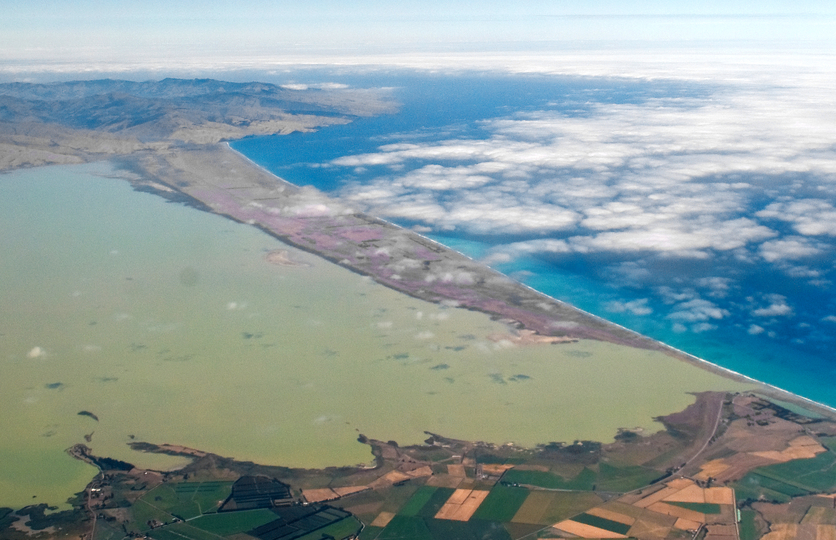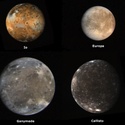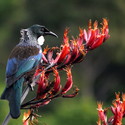Space and aerospace projects can have positive impacts on Aotearoa New Zealand that you might not expect. For instance, our space industry brings important opportunities to strengthen our kaitiakitanga of the whenua as well as tuarangi (outer space).
Aerospace at Kaitōrete
Kaitōrete, a narrow finger of land south of Ōtautahi Christchurch, has a long association with aerospace – NASA launched suborbital rockets from this area in the 1960s! Fast forward a few decades, and Kaitōrete was in the space launch spotlight again. Rocket Lab was interested in using Kaitōrete as the location to build the world’s first commercial orbital launch range. The company took part in various hui at local marae to form relationships and explain their intentions. In the end, Rocket Lab decided to build Launch Complex 1 on Māhia Peninsula, as this location allowed for a greater volume of launch events.
Kaitōrete still ticked all of the boxes for a launch site. It is in the right spot to provide access to desirable satellite orbits, it is close to Christchurch, an aerospace hub, and mana whenua were still interested.
The next step for Kaitōrete is Tāwhaki – an exciting development to restore the local ecosystems and develop aerospace opportunities for Aotearoa.
Tāwhaki
Tāwhaki is a joint venture between Te Taumutu Rūnanga and Wairewa Rūnanga, who are mana whenua and rangatira of Kaitōrete, and the New Zealand Government. The name Tāwhaki was chosen to acknowledge the ancestral connections between Ngāi Tahu and the demi-god Tāwhaki who sought celestial knowledge.
Having explored whakaaro around the kaupapa of space, mana whenua from Kaitōrete continued the conversation about aerospace with the New Zealand Space Agency. Rangatira from the area wanted to explore the opportunities the aerospace industry could bring to local communities. They could also see how space-related initiatives had potential to restore the area’s biodiversity.
Over time, farming practices and irrigation have impacted on the region of Kaitōrete. While the land and waters of Te Waihora Lake Ellesmere are in poor condition, the area is home to multiple at-risk and threatened species. The Rūnanga own land at either end of Kaitōrete Spit, and the joint partnership is purchasing about 1,000 ha in between these parcels of land.
In terms of kaitiakitanga, Tāwhaki holds the potential for applications in the following areas:
- Immediate rehabilitation work including fencing and the planting of native plants specific to the area.
- Pest control projects.
- Monitoring of te taiao/the environment.
- Studying ecology on the spit including karara (lizards) and plant species such as the rare coastal shrub tororaro (Muehlenbeckia astonii) and pīngao, which has value as a traditional weaving fibre.
- Preservation of two moths that are endemic to Kaitōrete Spit – Kupe’s grassmoth (Kupea electilis) and Kaitōrete jumper (Kiwaia jeanae).
People and communities
Kaitiakitanga also relates to caring for future generations of people and communities. Tāwhaki aims to create opportunities for employment for rangatahi of the region. Infrastructure that will benefit people and reflect the guardianship expectations of the community is under discussion. This could involve work in drone operation for sending emergency packages to someone stranded in the bush or establishing careers associated with rockets and physics. It will be important for Māori rangatahi to be present in the space industry so they can develop things that are important to them as Māori.
The Rūnanga have an enduring interest in protecting and preserving the land, and they have shared aspirations to create sustainable education pathways, employment opportunities through generating new business and high-skilled jobs, and attracting international investment.
Tāwhaki – a unique partnership for Kaitōrete
Related content
Watch this recorded professional learning session as Tame Malcolm (Kaimahi Matua at Te Tira Whakamātaki) shares some of his understandings regarding the concept of kaitiakitanga – including pūrākau connected to caring for the whenua.
Tame Malcolm also features in this recorded webinar about mātauranga, science and indigenous pest management.
Tāwhaki is part of the complex and extensive whakapapa of the origins of space. The Society of Māori Astronomy Research and Traditions (SMART) is dedicated to revitalising Māori astronomical knowledge.
The article Innovations in aerospace features Kea Aerospace – a company conducting test flights at Kaitōrete.
The article Working in the space sector profiles some of the space-related jobs available and the attitudes and dispositions that will help rangatahi succeed in these fields.
Activity ideas
Kaitiakitanga encompasses the care of te taiao – including tuarangi. Use the activity Creating a space treaty to consider aspects of kaitiakitanga as it relates to the space above the motu.
Tāwhaki aims to create opportunities for employment for rangatahi. The activity Can I work in the space industry? fosters blue-sky thinking about how and where tamariki and rangatahi might see themselves in the space industry.
Useful links
Learn more about the history of Te Waihora and ongoing work to restore the lake and its landscape.
Visit the MBIE website for more information on Tāwhaki – a unique partnership for Kaitōrete.
Visit the MBIE website for more information on the New Zealand Space Agency.
Acknowledgement
This resource has been produced with funding from the Ministry of Business, Innovation and Employment and the support of the New Zealand Space Agency.






